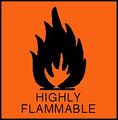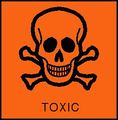|
|
| Line 15: |
Line 15: |
| | <br> | | <br> |
| | | | |
| − | Methanol material data safety sheet. Reproduced with kind permission of Department of Chemistry, Physical and Theoretical Chemistry Laboratory, Oxford University. | + | Methanol material data safety sheet. Reproduced with kind permission of the Department of Chemistry, Oxford University. |
| | | | |
| | Last updated January 8, 2004 | | Last updated January 8, 2004 |
Revision as of 00:49, 24 June 2011
Methanol material data safety sheet. Reproduced with kind permission of the Department of Chemistry, Oxford University.
Last updated January 8, 2004
| Common synonyms |
- Methyl alcohol
- Wood alcohol
- Meths
|
| Formula |
CH3OH
|
| Properties |
- Form: colourless liquid with a characteristic smell
- Stability: Stable, but very flammable
- Explosion limits 6% - 36%
- Water solubility: miscible in all proportions
|
| Principal hazards |
- Methanol is toxic. If ingested or inhaledit can cause a wide range of harmful effects, from sickness, heart and liver damage to reproductive harm, blindess or death.
- Methanol is often a component in "bootleg" liquor (illegally brewed and distilled alcohol) and there have been numerous cases in the past in which the consumption of such a drink has been fatal.
- Methanol is very flammable. The pure liquid catches fire easily and aqueous solutions containing a significant amount of methanol can also catch fire.
- The flame above burning methanol is virtually invisible, so it is not always easy to tell whether a methanol flame is still alight.
- The explosion limits for methanol (the lower and upper percentage limits of methanol in an air-methanol mixture giving a vapour that can explode) are unusually wide.
|
| Safe handling |
- Always wear safety glasses.
- Remove any source of ignition from the working area. Don't forget that a hot air gun, a hot plate or even a radiator may be sufficiently hot to ignite the vapour.
- You should not breathe in the vapour, so use a fume cupboard if available. If this is not possible, ensure that the area in which you work is very well ventilated.
|
| Emergency |
- Eye contact: Immediately flush the eye with plenty of water. Continue for several minutes and call for medical help.
- Skin contact: A person whose clothes are soaked in methanol will be at serious risk from fire, so immediately remove any contaminated clothing and store well away from a source of ignition (preferably outside). Wash exposed skin with soap and water. If the skin reddens or appears damaged, or if methanol may have been swallowed, call for medical aid.
- If swallowed: Call for immediate medical help; if the quantity swallowed is significant urgent medical action is vital.
|
| Disposal |
- Trace amounts of methanol can be flushed down a sink with a large quantity of water, unless local rules prohibit this.
- Larger amounts should be collected in a non-chlorinated waste solvent container for disposal.
|
| Protective equipment |
- Safety glasses.
- If you need gloves, butyl rubber is a suitable material.
|
| Further information |
More extensive safety data |
Bio-rich-time-poor 00:40, 24 June 2011 (BST)

